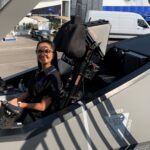When you go on a trip, you might reach for a map to help navigate your journey or pull up GPS on your phone. But what if the destination is on another planet, and there is no map? A new project sponsored by the International Space Station (ISS) National Laboratory could provide an assist.
Called the Multi-Resolution Scanner (MRS), the investigation will leverage NASA’s free-flying robotic Astrobee system on the space station to test a novel 3D mapping technology that can produce detailed maps of remote environments.
The project, a collaboration between Boeing and CSIRO (an Australian government agency responsible for scientific research), highlights the importance of international partnerships while building on the duo’s rich histories in the global space industry.
As Australia’s national science agency, CSIRO has significantly contributed to the space sector. For instance, during the Apollo 11 Moon landing in 1969, Murriyang, CSIRO’s Parkes radio telescope, received television signals from the historic event watched by nearly 600 million viewers worldwide.
Now, the organisation is working on a project that will benefit not only future exploration missions but also key industries on Earth.
MRS is designed to rapidly create 3D maps of various environments in unprecedented detail, like the space station or even a lava tube on the Moon or Mars. “We will use NASA’s free-flying Astrobee robots to test MRS, which will allow us to create 3D maps of the space station’s Kibo module,” said Marc Elmouttie, a research group leader at CSIRO.
“The technology we’re using combines multiple sensors, which compensates for weaknesses in any one of them and provides very high-resolution 3D data and more accurate trajectory data to understand how the robot moves around in space.”
Whether on the space station or the surface of Mars, robotic explorers must use onboard sensors and perception algorithms to simultaneously build detailed maps of the environment while localising themselves within it. This capability is called simultaneous localisation and mapping, or SLAM.
MRS relies on cutting-edge photogrammetry software called Stereo-Depth Fusion and 3D SLAM technology, which CSIRO calls Wildcat. The software enables MRS to map, analyse, and navigate its surrounding environment autonomously.
To validate that the software works in space, Elmouttie and his team are mapping a known location on the space station—the Kibo module. The investigation launched to the space station in March on SpaceX’s 30th Commercial Resupply Services (CRS) mission, contracted by NASA. After its arrival on station, MRS was installed into one of the three Astrobee robots.
Starting with Kibo allows the team to check the resulting maps against controls to see how well the technology functions in microgravity. Previous ground-based experiments have shown that the software’s highly accurate mapping and positioning capabilities could enable robots like Astrobee to successfully navigate unsafe, complex, and unstructured environments without GPS or other external positioning information.
If successful, MRS could expand to other modules on the space station, increasing its mapping capabilities. Results from this investigation will help advance the technology to the point where it could be used for future spaceflight missions and exploration endeavors.
The ISS has been continuously inhabited for more than 20 years, but future space stations may not all be crewed by humans. NASA’s planned lunar Gateway, and even other outposts in space, could be predominately crewed by robots. This technology would enable robotic helpers to keep systems going autonomously when humans aren’t present.
“Boeing is committed to providing improved capabilities and enhancing safety for trips to the Moon and beyond,” said Scott Copeland, director for ISS research integration at Boeing. “That requires the intersection of crew and robotic tasks, and the Multi-Resolution Scanning technology being demonstrated onboard our testbed in low Earth orbit will be a powerful tool to help us meet those goals.”
Subscribe to the FINN weekly newsletter

